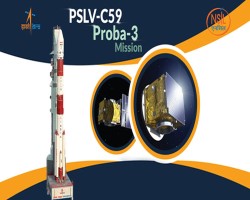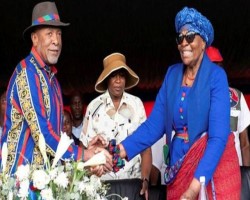SSC Current Affairs
TABLE OF CONTENTS |
| Science and Technology |
|---|
|
|
|
Why in the news?
After anomaly alert, ISRO sets PROBA-3 launch the PSLV-C59/PROBA-3 mission for 5th Dec, 2024. Proba-3, a European Space Agency (ESA) mission consisting of two satellites, is designed to study the solar corona—the outer layer of the Sun’s atmosphere. Key Takeaways: 1. The Proba-3 mission is developed at an estimated cost of 200 million euros with an expected mission life of two years. The ISRO will launch both the satellites stacked together in a highly elliptical orbit of 600 x 60530 km. Later, the satellites will be separated and put in a parallel orbit. 2. The mission is designed with two satellites that will be launched together, separate from each other, and then fly in tandem. This will be the first-ever attempt at “precision formation flying”, where two satellites will fly together and maintain a fixed configuration in space. 3. This is the latest solar mission in ESA’s Proba suite of missions. Its predecessors Proba-1 (also launched by ISRO) and Proba-2 were launched in 2001 and 2009, respectively. PSLV-C59, the launch vehicle, is an initiative led by NewSpace India Limited (NSIL) and supported by ISRO’s expertise. 4. The two satellites — Occulter Spacecraft (weighing 200 kg) and the Coronagraph Spacecraft (weighing 340 kg) — will mimic a natural solar eclipse. They will manoeuvre precisely in Earth’s orbit so that one satellite casts a shadow onto the other. 5. A naturally occurring solar eclipse allows solar physicists to observe and study the Sun’s corona for 10 minutes, across an average of about 1.5 eclipse events per year. Proba-3 will give six hours, equivalent to 50 such events annually, which will help deepen understanding of the Sun’s corona like never before. 6. Both the Occulter and the Coronagraph will face the Sun at all times. They will maintain a formation of a few millimetres and then move to a position where they will be 150 metres apart for six hours at a time. 7. One satellite will act as a viewing telescope, kept at the centre of a shadow cast by the other satellite positioned 150 metres away. This positioning will facilitate observing the Sun’s corona and will be autonomously achieved through precise flight formation. 8. If done successfully, the Occulter will create an artificial yet stable eclipse, by masking large parts of the Sun. As a result, the Sun’s blinding light will get blocked and only the solar corona will be visible to the coronagraph, which will photograph and facilitate studies of the lesser-known features. 9. Instruments on the Proba-3 mission: * The Association of Spacecraft for Polarimetric and Imaging Investigation of the Corona of the Sun (ASPIICS) or the coronagraph. Its field of view is between the Sun’s outer and inner corona, a circular belt normally observable during solar eclipse events. The instrument has a 1.4-metre diameter occulting disk mounted on it, to block the Sun’s light and facilitate a close-up view of this belt. * The Digital Absolute Radiometer (DARA) will maintain a continuous measurement of the Sun’s total energy output, known as the total solar irradiance. * The 3D Energetic Electron Spectrometer (3DEES) will measure electron fluxes as it passes through Earth’s radiation belts, providing data for space weather studies. Significance of the Study of the Sun 📍All space weather and its associated turbulences like solar storms, solar winds, and Coronal Mass Ejection (CME) originate from the corona. These phenomena influence space weather and can potentially interfere with the smooth operations of all satellite-based communications, navigation, and power grids on Earth. BEYOND THE NUGGET: Polar Satellite Launch Vehicle (PSLV) 1. The PROBA-3 Mission is the 61st flight of PSLV and the 26th using PSLV-XL configuration which is set to launch the spacecraft into a highly elliptical orbit as a Dedicated commercial mission of NewSpace India Limited (NSIL). 2. The Polar Satellite Launch Vehicle (PSLV) is the third generation of Indian satellite launch vehicles, first used in 1994. More than 50 successful PSLV launches have taken place to date. It has also been called “the workhorse of ISRO” for consistently delivering various satellites into low earth orbits (less than 2,000 km in altitude) with a high success rate. 3. PSLV-XL can lift 1,750 kg of payloads to the sun-synchronous polar orbit (spacecraft here are synchronised to always be in the same ‘fixed’ position relative to the Sun), and much more — 3,800 kg — to a lower Earth orbit (normally located at an altitude of less than 1,000 km but could be as low as 160 km above the planet). 4. PSLV has successfully launched two spacecraft Chandrayaan-1 in 2008 and Mars Orbiter Spacecraft in 2013. The launch of PSLV-C48 marks the 50th Launch of PSLV. Aditya-L1 mission, weighting 1,472 kg, was launched by PSLV-C57. |
|
|
|
Useful information for all competitive exams:
Indian Space Research Organisation (ISRO): Formed: 15 August 1969 Preceding agency: INCOSPAR (1962–1969) Headquarters: Bengaluru, Karnataka Chairman: S. Somanath (10th Chairman of the Indian Space Research Organisation) Primary spaceports: Satish Dhawan Space Centre, Thumba Equatorial Rocket Launching Station, Kulasekarapattinam Spaceport |
| Persons in News |
|
|
|
Why in the news?
Netumbo Nandi-Ndaitwah of Namibia’s ruling SWAPO party has been elected president and will be the country’s first female leader, results released by the country’s electoral commission. About Election: She received roughly 57% of valid votes in the presidential race, according to a breakdown given by the Electoral Commission of Namibia. Nandi-Ndaitwah needed to secure more than 50% of the votes to secure a win. Her main challenger in this election was Panduleni Itula from the Independent Patriots for Change (IPC) party, who came second with roughly 26% of votes. About Netumbo Nandi-Ndaitwah: Nandi-Ndaitwah, 72, is the current vice president. Her victory will extend SWAPO’s 34 years in power since it led Namibia to independence from apartheid South Africa in 1990. Nandi-Ndaitwah has been a member of SWAPO since the 1960s. She played an important role during the fight for independence. Her political career includes serving as foreign minister. She is regarded as a unifying figure within the party. Unlike some leaders, she has no corruption allegations against her. Namibia’s Demographics: Namibia has a population of three million people, which is one of the most sparsely populated countries globally. The country spans a vast area, twice the size of Germany. This demographic reality influences political dynamics and governance. |
|
|
|
Useful information for all competitive exams:
Namibia: Capital: Windhoek Current President: Nangolo Mbumba President Elect: Netumbo Nandi-Ndaitwah Currency: Namibian dollar (NAD), South African rand (ZAR) |
| Important Days |
|
|
|
Why in the News?
World Soil Day is celebrated annually on December 5 to highlight the importance of healthy soil. The day serves as a reminder of the critical role soils play in our ecosystem and the need to protect and conserve this invaluable resource for future generations. It also aims to raise awareness about soil degradation. This natural resource is made up of a mixture of minerals, organic matter, gases, liquids, and organisms. World Soil Day is celebrated globally, with various events and activities to raise awareness about soil conservation and its sustainable management. World Soil Day 2024 Theme: Every year, World Soil Day is given a special theme that focuses on a particular aspect of soil health and protection. These are carefully chosen to address the current issues and promote sustainable practices. This year, the theme of World Soil Day is “Caring for Soils: Measure, Monitor, Manage." It emphasises the need for accurate soil data and information to support sustainable soil management. World Soil Day 2024: History The day was first recommended by the International Union of Soil Sciences in 2002, which was supported by the Food and Agricultural Organisation of the United States (FAO). The day was then established under the leadership of the Kingdom of Thailand within the framework of the Global Soil Partnership. Later in 2013, the FAO Conference endorsed the day and urged that World Soil Day be formally adopted at the 68th United Nations General Assembly. The UNGA designated December 5, 2014, as the first World Soil Day. World Soil Day 2024: Key Facts It is estimated that 95% of our food directly or indirectly comes from soil. It provides essential nutrients, water, oxygen and root support for plants to grow and flourish. According to Food and Agriculture organisation, 33 percent of the Earth’s soil is already degraded because of factors such as deforestation and mining. It is also estimated that 90 percent could become degraded by 2050. It can take up to 1,000 years to produce just 2-3 cm of soil. It is formed through the slow physical, chemical, and biological weathering of bedrock. Soil is vital for our existence because it’s a fundamental resource for life on Earth. It is made up of layers that include the organic layer, topsoil, subsoil, and bedrock. Soil comes in many different colours, including red, brown, yellow, black, and gray. Soil is one of our most important weapons in the fight against climate change, as it contains more carbon than the atmosphere and all of the world’s plants and forests combined. INDIA’S SOIL HEALTH CHALLENGES: In India, the world's second-most populous country, soil health is a pressing issue. Excessive use of chemical fertilisers, over-irrigation, and deforestation have led to declining fertility in many agricultural zones. Government initiatives like the Soil Health Card Scheme and efforts to promote organic farming are steps in the right direction, but much more remains to be done. WHAT CAN YOU DO? Improving soil health isn’t just the responsibility of farmers or policymakers. As global citizens, small actions can make a big impact: Compost organic waste: Turn kitchen scraps into nutrient-rich compost instead of discarding them. Plant trees and native vegetation: These help prevent soil erosion and maintain ecological balance. Educate others: Awareness is key. Share information on soil conservation practices. Support sustainable farming practices: Choose organic and locally grown produce. |
|
|
|
Useful information for all competitive exams:
International Union of Soil Sciences: Formation: 1924 Headquarters: Rome, Italy President: Edoardo Costantini (Italy) Parent organization: International Science Council Food and Agriculture Organization (FAO): Formation: 16 October 1945 Founded at: Quebec City, Canada Type: United Nations specialized agency Headquarters: Rome, Italy Director-General (9th): Qu Dongyu (China) Parent organization: United Nations Economic and Social Council |
|
|
|
In Short:
World Soil Day is observed on December 5 to highlight soil's importance Over 33% of global soils are degraded due to human activities The theme Caring for Soils: Measure, Monitor, Manage." |
|
<< 4-Dec-24
|
|
|


